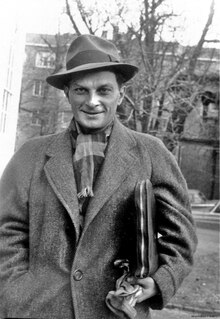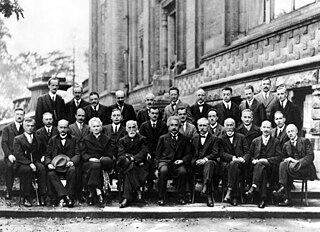
Stanisław Marcin Ulam was a Polish-American scientist in the fields of mathematics and nuclear physics. He participated in the Manhattan Project, originated the Teller–Ulam design of thermonuclear weapons, discovered the concept of the cellular automaton, invented the Monte Carlo method of computation, and suggested nuclear pulse propulsion. In pure and applied mathematics, he proved some theorems and proposed several conjectures.
Enrico Fermi (1901–1954) was an Italian physicist who created the world's first nuclear reactor.

In physics and thermodynamics, the ergodic hypothesis says that, over long periods of time, the time spent by a system in some region of the phase space of microstates with the same energy is proportional to the volume of this region, i.e., that all accessible microstates are equiprobable over a long period of time.
The year 1953 involved numerous significant events in science and technology, including the first description of the DNA double helix, the discovery of neutrinos, and the release of the first polio vaccine.
John R. Pasta was an American computational physicist and computer scientist who is remembered today for the Fermi–Pasta–Ulam–Tsingou experiment, the result of which was much discussed among physicists and researchers in the fields of dynamical systems and chaos theory, and as the head of the department of Computer Science at the University of Illinois at Urbana-Champaign from 1964 to 1970.
In physics, the Fermi–Pasta–Ulam–Tsingou problem or formerly the Fermi–Pasta–Ulam problem was the apparent paradox in chaos theory that many complicated enough physical systems exhibited almost exactly periodic behavior – called Fermi–Pasta–Ulam–Tsingou recurrence – instead of the expected ergodic behavior. This came as a surprise, as Fermi, certainly, expected the system to thermalize in a fairly short time. That is, it was expected for all vibrational modes to eventually appear with equal strength, as per the equipartition theorem, or, more generally, the ergodic hypothesis. Yet here was a system that appeared to evade the ergodic hypothesis. Although the recurrence is easily observed, it eventually became apparent that over much, much longer time periods, the system does eventually thermalize. Multiple competing theories have been proposed to explain the behavior of the system, and it remains a topic of active research.

A golden age of physics appears to have been delineated for certain periods of progress in the physics sciences, and this includes the previous and current developments of cosmology and astronomy. Each "golden age" introduces significant advancements in theoretical and experimental methods. Discernible time periods marking a "golden age" of advancements are, for example, the development of mechanics under Galileo (1564–1642) and Newton (1642–1727). Another small epoch seen as a golden age is the unification of electricity, magnetism, and optics because of 19th century notables, including Faraday, Maxwell, and others.
The mathematical discipline of topological combinatorics is the application of topological and algebro-topological methods to solving problems in combinatorics.
This is a timeline of pure and applied mathematics history. It is divided here into three stages, corresponding to stages in the development of mathematical notation: a "rhetorical" stage in which calculations are described purely by words, a "syncopated" stage in which quantities and common algebraic operations are beginning to be represented by symbolic abbreviations, and finally a "symbolic" stage, in which comprehensive notational systems for formulas are the norm.
FPU may stand for:
The following timeline starts with the invention of the modern computer in the late interwar period.
The following is a timeline of scientific computing, also known as computational science.

Mary Tsingou is an American physicist and mathematician of Greek descent. She was one of the first programmers on the MANIAC computer at Los Alamos National Laboratory and is best known for having coded the celebrated computer experiment with Enrico Fermi, John Pasta, and Stanislaw Ulam which became an inspiration for the fields of chaos theory and scientific computing and was a turning point in soliton theory.
The index of physics articles is split into multiple pages due to its size.
This is a timeline of key developments in computational mathematics.
In mathematics, the Erdős–Ulam problem asks whether the plane contains a dense set of points whose Euclidean distances are all rational numbers. It is named after Paul Erdős and Stanislaw Ulam.
Using the Borsuk–Ulam Theorem: Lectures on Topological Methods in Combinatorics and Geometry is a graduate-level mathematics textbook in topological combinatorics. It describes the use of results in topology, and in particular the Borsuk–Ulam theorem, to prove theorems in combinatorics and discrete geometry. It was written by Czech mathematician Jiří Matoušek, and published in 2003 by Springer-Verlag in their Universitext series (ISBN 978-3-540-00362-5).